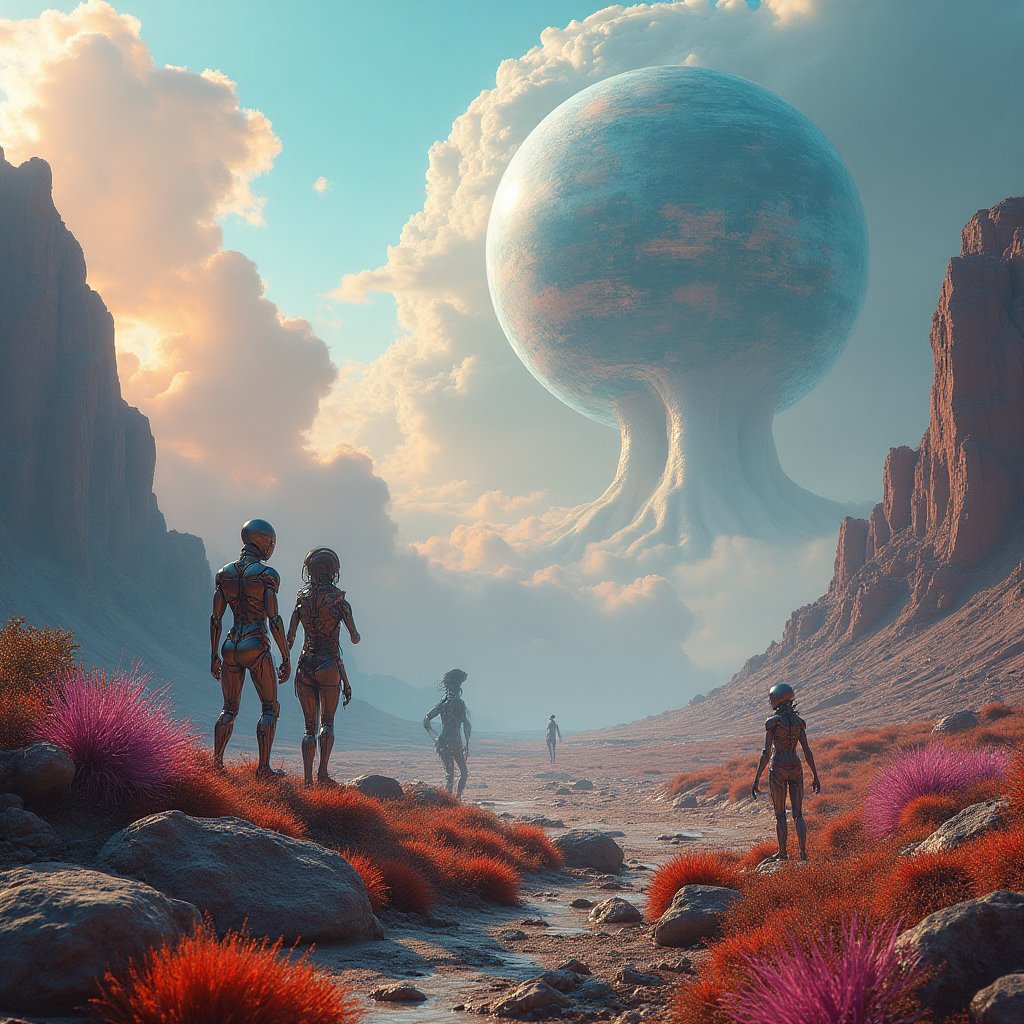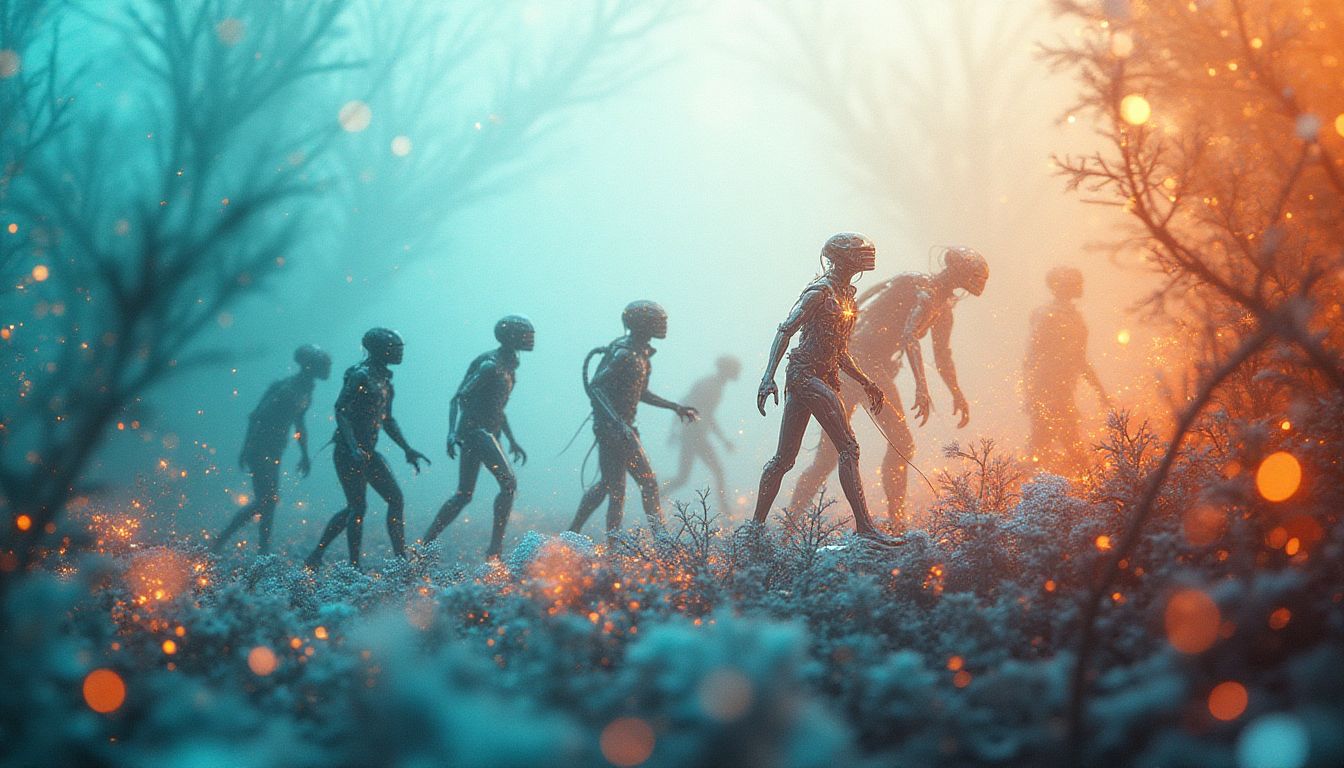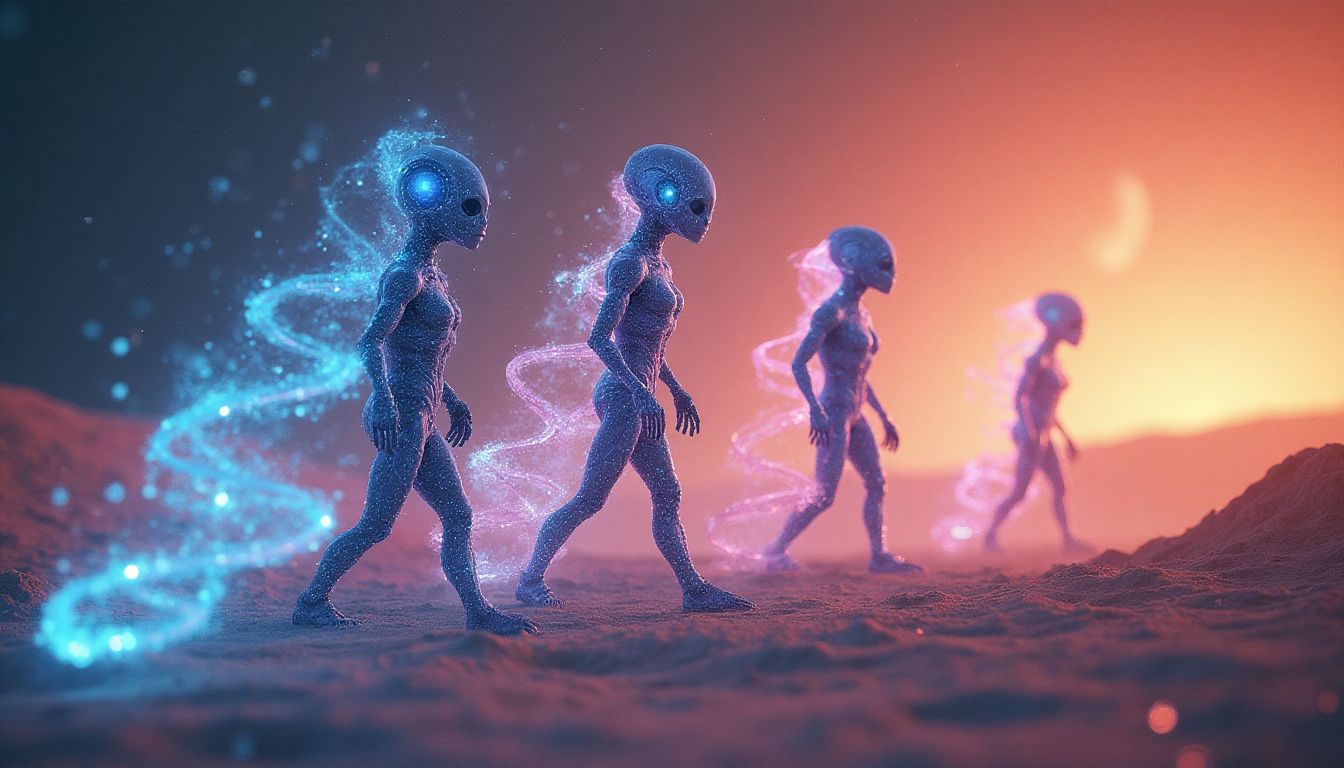Introduction: The Wonders Beyond
The measure of intelligence is the ability to change. – Albert Einstein. In the grand dance of evolution, it is adaptation that takes the lead. While the universe around us unfolds in complex choreography, humanity prepares for a new act unlike any seen before—a leap from Homo sapiens to something beyond, guided by artificial intelligence (AI). This transition isn’t just about surviving in new environments; it’s about thrumming with the very rhythm of existence itself. Could AI be the grand maestro in orchestrating this new form of life?
This is not science fiction anymore. It's the vibrant, tangible exploration of what it means to be human. With CRISPR’s technological prowess and AI as our guide, we stand on the cusp of a brave, bizarre new world. Ready to join this odyssey? Let’s see what's on the horizon!
The Science of Genetic Tailoring
Genetic tailoring offers humanity the ultimate toolkit for evolution. Imagine CRISPR as the most precise genetic scalpel, snipping strands of DNA with the finesse akin to a master jeweler. It's like editing a word document, fixing typos in our genetic "code," aiming to create the perfect balance for life beyond Earth.
CRISPR has given us a taste of what's possible by adjusting genes almost as effortlessly as a DJ spins records. Despite the science-fiction aura surrounding it, CRISPR is as real as your morning coffee. Jennifer Doudna, a pioneer in this field, regards it as a revolution in biology, fundamentally altering what it means to be genetically unique.
CRISPR and Beyond
Many luminaries, including George Church and Emmanuelle Charpentier, have illuminated the possibilities with CRISPR. It can edit genes with such precision that future humans might withstand cosmic radiation or even breathe in atmospheres as thin as car salesmen promises. Here we marry the mechanical prowess of AI with the biological art of gene editing to craft beings that are ready for anything the universe throws at them.
Synthetic Biology’s Role
Synthetic biology is the rebellious sibling, pushing the boundaries further by engineering genes from scratch. It's as if we've found a new color palette with which to paint life itself! This field allows us to design organisms that could, say, photosynthesize like plants, making them self-sustainable on a desolate alien surface. Craig Venter, celebrated for his work with synthetic genomes, invited us to envision a world where humanity, melded with technology, could thrive anywhere—perhaps even on Mars.
In this dazzling dance of genes and algorithms, synthetic biology stands as both creator and choreographer. It prompts the question—if we can artfully redesign life, can extinction be a choice rather than an inevitability? Consider this the dawn of a new epoch—a bold ballet courtesy of genetic tailoring and its electric partner, AI.
Human Adaptation to Alien Environments
Picture this: stepping onto a new planet, where everything from the air you breathe to the gravity that grounds you is different. It’s like dropping a penguin into a desert. Adaptation is not just about surviving; it’s about thriving. Here, we delve into how we could acquire the necessary traits to call these foreign landscapes 'home.'
Understanding Alien Terrains
Imagine each potential new home as a galactic Goldilocks zone—not too hot, not too cold, but potentially just right. Every planet has unique characteristics. Take Mars, for example, where thin air and radiation storms make it an extreme neighborhood (NASA Mars Exploration Program).
To thrive, we need to understand these terrains meticulously. It's a science detective story, with clues littered in the atmospheric pressure, carbon dioxide levels, and gravitational force of each celestial body. Friendly reminder: don’t pack a bag until you know the lay of the land!
Defining Adaptation Parameters
Now, let’s get science-y (but fun). Adaptation metrics must be measured and tailored, kind of like getting a new spaceship suit adjusted. We need to evaluate our resistance to radiation, improve our oxygen efficiency, and even tweak our physiology to fit these off-world runways. Our goals are no less ambitious than tweaking beings for ultimate cosmic comfort.
These adaptations serve as a space-faring Swiss Army knife for our genes, each one designed with a specific problem-solving aim. Picture astronauts with lungs akin to Sherpas climbing Everest—capable of sifting through thin atmospheres for a gulp of much-needed oxygen.
Ethical Considerations in Genetic Modification
Sure, turning ourselves into superhuman versions sounds like downloading the latest app update. But are we overlooking the fine print? The ethics of genetic tinkering is a debate as heated as pineapple on pizza. Do we have the right to alter what makes us, well, us? Prepare yourself for some heavy-duty pondering.
The Moral Quandary
Let's delve into this genetic Pandora's box. The morality of playing god with DNA isn’t just a conversation starter at a [MIT](https://web.mit.edu/) faculty gathering; it challenges our fundamental beliefs. Do designer babies come with a return policy? And what about consent? How do we ensure that those born into this edited existence aren't reduced to mere works of art, stripped of autonomy?
Creating beings beneath the starry night, like crafting a cosmic choir, is a tricky compass to navigate. We risk altering identities and shaking the very core of what it means to be human if we’re not cautious.
Understanding Ecosystem Impacts
And it doesn't stop with us. As if a butterfly flapping its wings, genetic edits could ripple through ecosystems, much like invasive species turning native habitats topsy-turvy. Introducing newly-minted humans onto another Earth isn't the sci-fi fairytale it might seem. We must weigh the pros and cons like deciding between two favorite desserts, ensuring that our scientific ventures don't tip cosmic scales.
Overall, before charging full steam ahead into these genetic ventures, it's pivotal to remember these artistically crafted humans would live not just in new worlds but with us, bringing potential environmental ripples. Careful, now—handle with responsibly engineered care!
The Role of Artificial Intelligence in Evolutionary Biology
Imagine a future where the secrets of evolution are unraveled not through painstaking manual research but through the lightning speed of artificial intelligence. By harnessing the power of AI, scientists can simulate genetic modifications, analyze data, and predict successful adaptations with accuracy and efficiency. In this brave new world, AI is not just an assistant; it's a trailblazer.
AI Models for Genetic Simulation
As we delve into the potential of AI models like IBM Watson, it's clear how they can revolutionize genetic simulation. These advancements allow researchers to simulate genetic mutations and their possible outcomes before taking tangible steps. Imagine being able to forecast the chance of a trait surviving on Mars. AI can make this possible, guiding decisions with precision and minimizing risk.
The power of genetic simulation can be broken down into:
- Simulation Speed: Quickly modeling countless environmental and genetic scenarios.
- Cost Efficiency: Reducing the need for physical trials.
- Accuracy: Achieving high precision in predicting successful adaptations.
Data Analysis and Predictive Analytics
AI's prowess in data analysis is unparalleled. Consider the vast swathes of genetic data collected from across the globe. AI tools like Google AI have the capacity to sift through this data, identifying trends and making predictions in ways our human minds simply can't match.
The role of predictive analytics is vital here:
- Big Data: Harnessing genetic and environmental parameters to forecast evolutionary successes.
- Adaptation Predictions: Anticipating which adaptations are likely to thrive in alien terrains.
- Strategic Planning: Utilizing predictive insights to guide long-term genetic research goals.
Through AI's intelligent capabilities, we stand on the cusp of using data not just to learn—but to thrive.
Case Studies: Successful Biological Adaptations
Our planet is a living library of biological adaptations. Species have thrived in extreme environments, teaching us precious lessons about survival and resilience. By studying these cases, we can glean insights for our journey into the stars.
Extremophiles and Their Genes
Take, for instance, the extremophiles—organisms that defy odds by living in environments lethal to most. These include the Thermus aquaticus, thriving in Yellowstone’s scorching hot springs, and the tardigrades, which endure the vacuum of space.
Here's what we can learn from them:
| Organism | Adaptation | Lesson |
|---|---|---|
| Thermus aquaticus | Heat tolerance | Potential for genes that withstand high temperatures. |
| Tardigrades | Space survival | A blueprint for enduring extreme environments. |
Evolutionary Success Stories
Beyond extremophiles, Earth's wildlife showcases remarkable adaptations. The emperor penguin thrives in Antarctica's icy expanse. As humanity embarks on interplanetary endeavors, the resilience of these birds in sub-zero temperatures might inspire our quest for survival in cold, distant worlds.
Similarly, the peregrine falcon boasts remarkable vision and speed, attributes driven by evolution that may guide advancements in human sensory enhancements.
Studying these evolutionary marvels and their success stories lights a clear path as we aim to conquer new frontiers.
AI Solutions: How Would AI Tackle This Issue?
AI has the potential to be the backbone of our genetic modification endeavors, providing solutions that were once considered the stuff of dreams. Imagine a world where artificial intelligence doesn’t just support but actively guides the evolution of humanity! Here are some innovative steps and frameworks for adopting AI in our quest for tailored adaptations to thrive in alien environments.
First, we need foundational data. Machine learning algorithms require mountains of data to learn and make predictions. We want comprehensive databases encompassing human genetics, environmental challenges, and species' responses. This undertaking would rely on the collaboration of geneticists, data scientists, and ever-advancing software engineers. With organizations like the Baylor College of Medicine Human Genome Sequencing Center paving the way in genomics, we can gather diverse datasets and use platforms like GENCODE for gene structure information.
Next, we introduce predictive simulation models. AI can be harnessed to run simulations that predict how specific genetic modifications will fare in various extraterrestrial environments. Here’s where platforms such as OpenAI could offer powerful tools. By applying reinforcement learning techniques, we can test variables of gene edits and their possible outcomes in virtual ecosystems before making real-world changes.
Big data comes to life in the analysis phase. Employing neural networks to analyze the interactions between genetic codes and environmental factors can guide our understanding of adaptations. We should implement real-time decision-making frameworks that adjust based on current data inputs, ensuring our approaches remain agile. Collaborating with giants like IBM's Watson could empower us to handle vast datasets and realize rapid iteration.
Finally, let’s consider ethical parameters alongside our technological advancements. AI can help us create frameworks to anticipate the moral and ecological concerns surrounding genetic modification. Supervised learning algorithms can analyze public sentiment and ethical dilemmas, ensuring that genetic modifications are aligned with a broader policy framework. We could initiate workshops and coordinated efforts with entities like the National Bioethics Advisory Commission to build consensus and transparency in decision-making.
Actions Schedule/Roadmap (Day 1 to Year 2)
Day 1:
Assemble a multidisciplinary team of geneticists, AI specialists, ethicists, and environmental scientists. This foundational step will include reaching out to high-impact institutions, possibly including University of Chicago and MIT, to engage leading experts.
Day 2:
Begin baseline data collection on human genetic makeup while simultaneously gathering environmental data on potential extraterrestrial habitats. Real-time sensors and data collection units from companies like Space.com can yield critical insights regarding atmospheres and terrains.
Day 3:
Host a brainstorming session that involves both scientists and ethicists. Discussions should revolve around anticipated alien environments and potential adaptations for human survival. This session will lay the groundwork for defining research directions.
Week 1:
Conduct exploratory research into existing genetic modifications, examining their impacts on various species. Check collaborations with others who have experience in real-world applications, like Cold Spring Harbor Laboratory.
Week 2:
Develop initial models predicting genetic alterations necessary for each alien environment identified in the brainstorming session. Utilize simulated environments modeled through AI algorithms to predict outcomes before experimental operations are conducted.
Week 3:
Initiate testing of simulation algorithms and ethical paradigms. Include public consultations to gauge societal awareness and readiness, connecting with organizations like the American Medical Association for insights on community engagement.
Month 1:
Compile reports on the first round of findings, effectively communicating these insights to stakeholders to ensure informed decision-making and transparency.
Month 2:
Focus on optimizing data analysis techniques. Partner with tech companies, such as Microsoft Research, to enhance data processing capabilities.
Month 3:
Finalize collaboration agreements with universities, like Stanford University, to unify research efforts and promote sharing of knowledge.
Year 1:
Launch pilot studies for low-stakes gene editing trials on willing human volunteers under a comprehensive ethical framework. The collaboration should include oversight from ethical review boards and legal experts.
Year 1.5:
Analyze progress and adjust research directions as necessary. Understand what data has been collected, what theories hold and what doesn’t, in anticipation of adjustments to our framework.
Year 2:
Introduce outreach programs aimed at educating the public about the potential of human evolution in extraterrestrial environments, ensuring transparency and ongoing support. Create partnerships with educational institutions to increase awareness among younger populations, seeding interest in the fields of genetics and space exploration.
Conclusion: The Journey Ahead
As we stand at a crossroads between biological innovation and ethical responsibility, our journey toward evolving into post-human species poised to explore other worlds reveals the dual challenge of not only survival but our character as a species. The intertwining forces of AI and genetic manipulation bring opportunities for adaptation that were once confined to science fiction. It’s a complex dance, where science fiction meets reality, weaving together threads of curiosity, fear, ambition, and hope.
To evolve or not to evolve? This is not merely a question; it’s a monumental dilemma that could redefine the essence of humanity itself. The echoes of our scientific strides ripple through the corridors of time, nudging us to ask: will we enrich the human experience through exploration and evolution, or will we remain sedentary, prisoners of our nature?
As we descend into this uncharted territory, we must navigate the murky waters of ethics, acknowledge the profound responsibilities that come with altering our very genome, and engage in collaborative discussions that include voices from various communities, ensuring that our quest for the stars is embodied in a shared humanity. These next steps are crucial, not only for the destiny of our species, but also for the legacy we leave for generations to come.
It is time to rally, to convert ambition into action, and to realize a future forged through collaboration, innovation, and care. Humanity's quest for the cosmos will shape the next chapter of our story. Are we ready to write it together?
FAQ
Q: What is AI-guided evolution?
A: AI-guided evolution refers to using artificial intelligence (AI) tools to influence human genetic changes. The goal is to create adaptations that help us survive in tough environments, like those found on other planets. So, instead of just waiting for nature to take its course, we're using smart technology to help direct the path of our evolution.
Q: What are genetic modifications?
A: Genetic modifications involve changing the genes of an organism. Scientists can edit genes to make plants grow bigger or resist diseases, and in humans, they could help with genetic disorders or even allow us to adapt to environments outside of Earth. CRISPR is one of the most well-known tools used for gene editing.
Q: What are some ethical concerns around genetic modification?
A: There are many important questions we need to think about when it comes to changing genes. Here are a few:
- Who decides? If we make changes to genes, who gets to decide what changes are okay?
- Identity: How will these changes affect a person's identity or sense of self?
- Nature's balance: What happens to the ecosystem if we change humans or other living things?
Q: How can AI help us in the genetic modification process?
A: AI can play a big role in understanding how genes work and what changes might be successful. Here’s how:
- Simulations: AI can create models to simulate what might happen if certain genes were changed.
- Data analysis: By analyzing loads of information, AI can help scientists find patterns in genetic changes that lead to successful adaptations.
Q: What types of adaptations might we need for surviving on alien worlds?
Adapting to new planets may mean we need to change our bodies in various ways. Some possible adaptations could include:
- Better protection against high radiation levels.
- Improved oxygen efficiency for thin atmospheres.
- Physical changes to help us move and live in different gravity conditions.
Q: How long will these projects take?
A: Starting initial research can take a couple of years, but making real changes to humans ready for other planets is a long journey. It could take decades before we see significant results. NASA and other space organizations will be key players in this ongoing effort.
Q: Will genetic modifications change the way we see human nature?
A: That’s a big question! As we make these changes, we may need to rethink what it means to be human. If we start creating people who can thrive outside Earth, will they still be seen as the same as us? This topic opens up a lot of interesting discussions about our identity, rights, and responsibilities.
Q: Who else is working on similar ideas?
Many scientists and organizations are exploring genetic modifications and AI. For example, researchers at places like Harvard University and MIT are leaders in the fields of genetics and biotechnology. Collaborations with space agencies like ESA (European Space Agency) also play a big part in space adaptation research.
Wait! There's more...check out our gripping short story that continues the journey: This is for those who never knew what was coming.
Disclaimer: This article may contain affiliate links. If you click on these links and make a purchase, we may receive a commission at no additional cost to you. Our recommendations and reviews are always independent and objective, aiming to provide you with the best information and resources.
Get Exclusive Stories, Photos, Art & Offers - Subscribe Today!





























Post Comment
You must be logged in to post a comment.